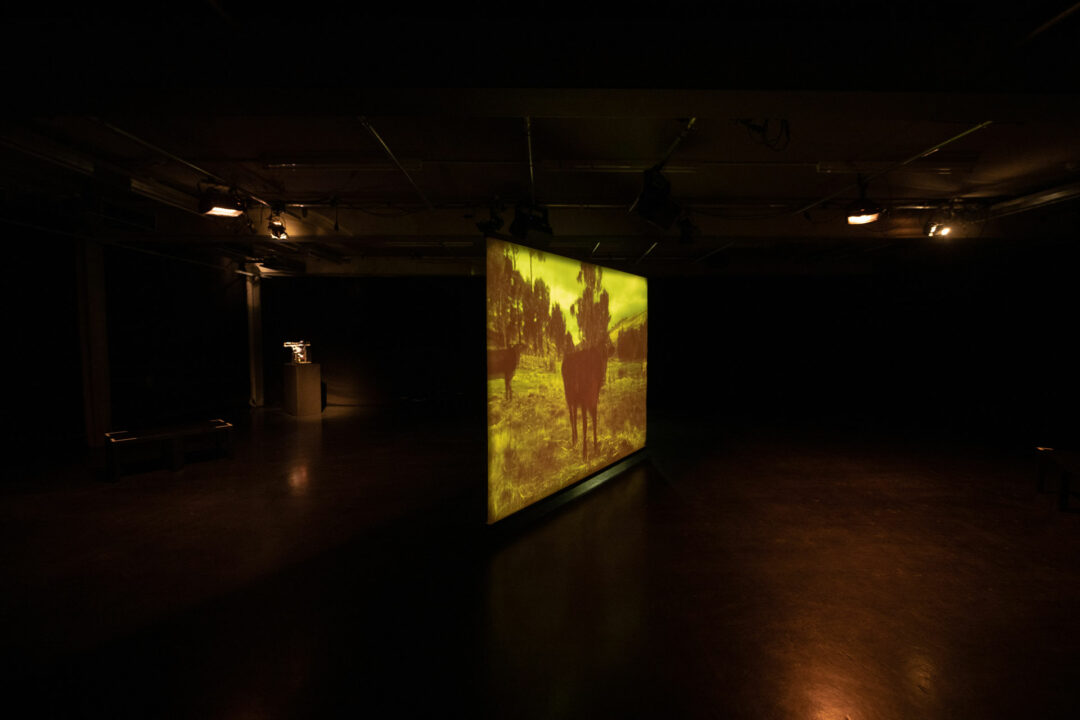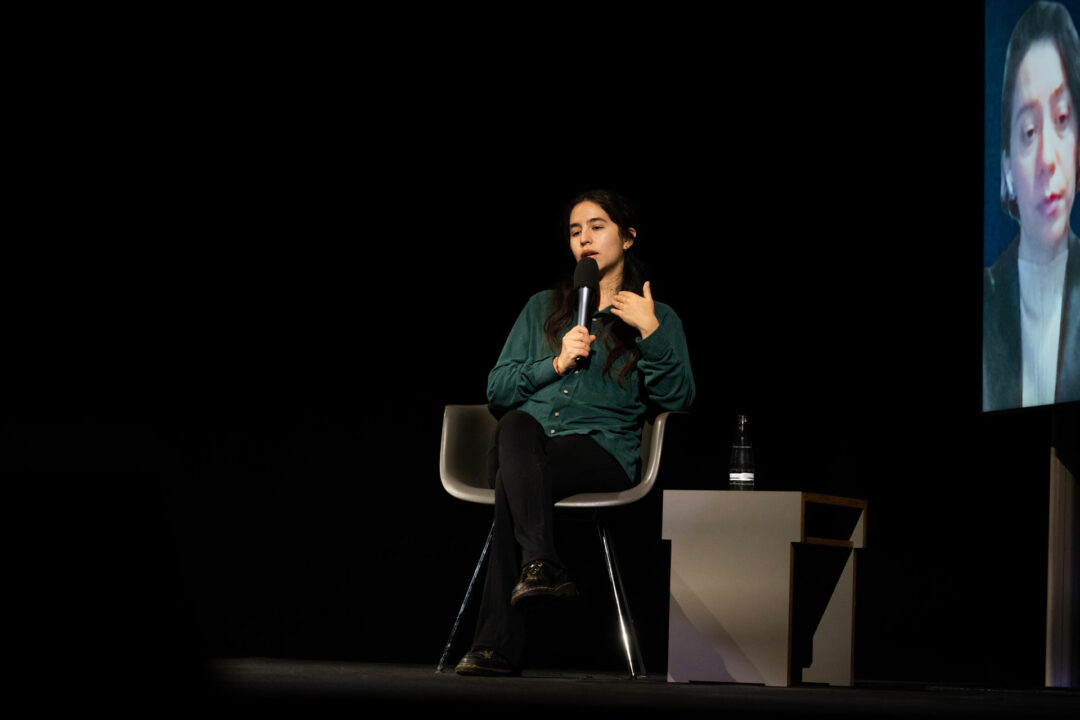Text by Stella Sideli
Photos by Camille Blake

The work What Humans See as Blood, Jaguars See as Chicha borrows its title from a Latin American phrase sometimes used in archeological and anthropological research, which talks about other-than-human perception. It refers to the coexistence of different points of view and the perspectives of a variety of entities, including humans, animals, stones, mountains, and lakes. But another way of interpreting the title of Luciana Decker Orozco’s work is as being inspired by wooden keros and gold or silver aquillas—conical drinking vessels used throughout the Incan Empire for the ritual consumption of chicha, or maize beer. The jaguar-like creature often carved into a kero’s rim may depict a katari, a fantastic animal combining feline and reptilian characteristics.
By evoking the ritualistic object, Orozco introduces some of the work’s central elements. It alludes to the entanglement of humans, animals, and nature as well as cultural, social, and historical artifacts. But the title also highlights the work’s philosophy, namely that of interrelating—both as an act unto itself and as an ontology. People, deities, sacred and haunted entities, objects, spaces, and natural forces are all main protagonists, portrayed in the work chorally and equally. This act of interrelating is further echoed in how the work is experienced: it is installation-based, centered on a 16mm film projection, and activated by a performance that recalls the interdisciplinary experimentalism of artist Joan Jonas, or the embodied mysticism of performance artist María Teresa Hincapié.
Orozco shot the 16mm film in the region of Kalaque, Bolivia, where family ties connect the artist’s past, present, and future. For her, Kalaque is a place of origin that continuously calls her back in visceral yet nurturing ways. The Andean region’s unusual geological formations are therefore departure points for a journey that travels inward and outward at the same time. The work constitutes a personal quest that also manifests collectivity, going beyond the artist’s circumstances. It somehow involves you, me, others—everything.
Orozco explores the oral traditions of elaborate horror stories told about the region’s nature, marking it as “haunted” and thereby contributing to its protection. Only loosely narrative-driven, the work becomes a tale of something osmotic, like breathing—in, out, in, out—a set of connected movements that must converge to keep us alive, in a sort of embodied planetary rhythm, which, in the words of Bolivian scholar and activist Silvia Rivera Cusicanqui, involves the lungs, heart, and liver and allows us to think, know, relate, and connect. Orozco situates herself—her body, memories, identity, actions—as entangled with the landscape and the local community. It’s in this space that the film exists, in the fluid tension between one and many, inside and outside, nature and culture, past and future. It is a space of potential, in which the expanded and unexpected connections between these elements are afforded through different layers of understanding.
But what do we, as viewers, bring into the space when we interact with the installation? This question was fundamental to the process of making the work, and is reflected, for example, in the collective use of the camera. Filming and directing were shared between the artist and the local community in a continuous exchange of power and perspectives. There’s a constant shift in who is looking through the lens and who’s being captured on film; who gets to remember and relate a story; who has the right to think about the future; and who holds the power to imagine and world-build. Tales of spirits, legends, haunted springs and ojos de agua, fragments of life, embodied emotions, and natural forces are all co-narrated in a way that, essentially, tells of a collective inhabiting of this world.
And if world-building is so soundly an act of imagining, it becomes clear that this act of imagining cannot be ours alone. It is shared by wak’a, a sacred body, a territory, concentrating natural energy and manifesting itself in the form of mountains, grass, thunder, or lakes and a pure, cosmic personhood. Orozco requested permission not only to film people in the community, but all other things perceived as living beings as well, such as the wind, the mountains, the rain, or the plants, accumulating rituals that can mediate those encounters. Having established relationships that are non-extractive and non-exploitative, Orozco is aware of the different nuances that the project commits to because of, or rather thanks to, its diverse protagonists.
But there are additional instances of feminist, decolonial practices in Orozco’s work. She manipulated the celluloid film with soil, an act that, far from violent, seeks to be one that restitutes matter to its source, imbuing the process with an earthly character, in a trusting collaboration, and with an unexpected result. This tactile approach is familiar to the Kalaque people. Unlike Western epistemology, which is strongly linked to seeing and visual input, in Kalaque, making sense primarily relates to using hands and bodies in order to know and interact: sewing, crafting, and working the land in non-invasive ways reflect a spiritual and gentle connection with the earth. Indeed, ecological sustainability and the ethics of waste inform another act of resistance in Orozco’s work, who is using 16mm film for the first time.
While digital video can be taken, re-taken, edited, and deleted, working with analogue film requires a different way of thinking. Each moment will be imprinted on the celluloid material, therefore almost forcing itself into the world, taking space, demanding to be seen. With its ever-present sense of a vital flow and interconnection with a multitude of others, the work rejects binary oppositions and, as a political vision, eschews a dialectics that pitches self-versus-other. It’s this sense of being connected to other beings that we are left with after experiencing Orozco’s work, an enhanced ability to understand and, hopefully, embody more ecologically sound relationships, and the capacity to shift approaches and switch perspectives, moving towards empathy and belonging.




